I don’t profess to be an expert in the field of geography, but I can say with confidence that there aren’t too many places in the world where the land and sea form as perfect a union as they do in Cabo San Lucas, Mexico.
Located at the southern-most tip of the Baja California peninsula, what was once a quiet fishing village is now a vibrant city of 80,000 and one of the most popular tourist destinations in the world. Together with its sister city of San Jose del Cabo, the two towns comprise a metropolitan area of 300,000 inhabitants commonly referred to as “Los Cabos”. Since 1990, the area has tripled in size resulting in a 20-mile stretch featuring many of Mexico’s best hotels, restaurants, golf courses and beaches appropriately named the “Tourist Corridor”.
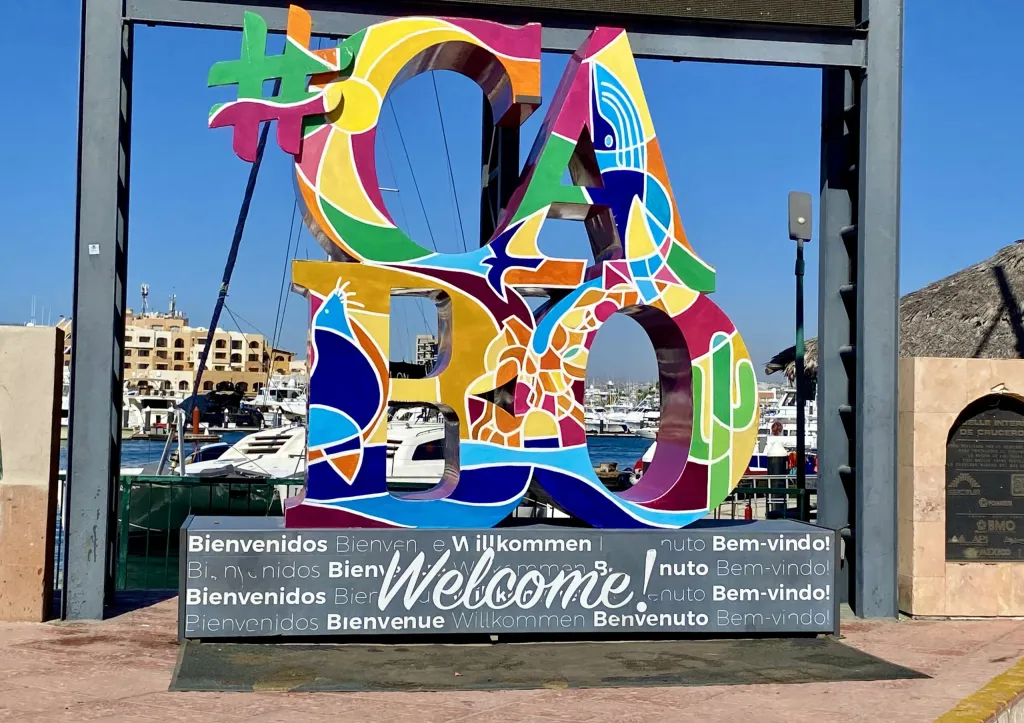
Welcome to Cabo!
It is here in Los Cabos where the calmer waters of the Sea of Cortez clash with the mighty Pacific Ocean and the land truly comes to an end. Over 1,000 miles in length, the Baja California peninsula is the second longest in the world. To put that into context, it is longer than the country of Italy. From any vantage point overlooking the aqua marine waters, you’ll see Cabo’s iconic limestone landmark known as El Arco or “The Arch”. This truly is Land’s End, as your next landing point from this jagged rock formation is the South Pole, 12,500 kilometres away.
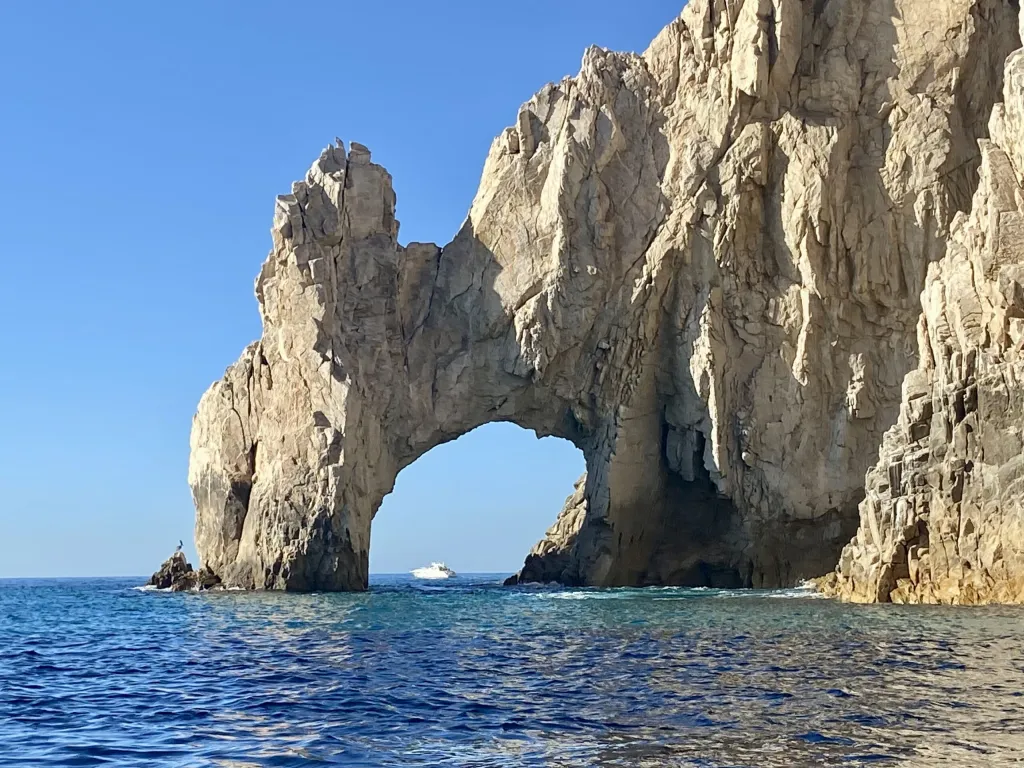
El Arco Land’s End
Featuring an arid desert climate and miles of pristine beaches, Los Cabos is a place people come to engage in a variety of exciting outdoor activities and indulge in diverse culinary delights. It is a destination that has something for everyone. The weather is perfect as temperatures average 24 degrees centigrade and the sun shines 350 days a year.
For outdoor enthusiasts, April through December is the ideal time to visit Los Cabos as it is during these months you will see a variety of migrating whales arriving from the cold Alaskan waters 7,000 km away. There are eight species of whales that migrate to the tip of the Baja Peninsula including Humpbacks, Orcas, and giant Blues. The most common visitor is the California Gray whale which arrives to gorge in the plankton-rich sea and calve after a 10–12-month gestation period.
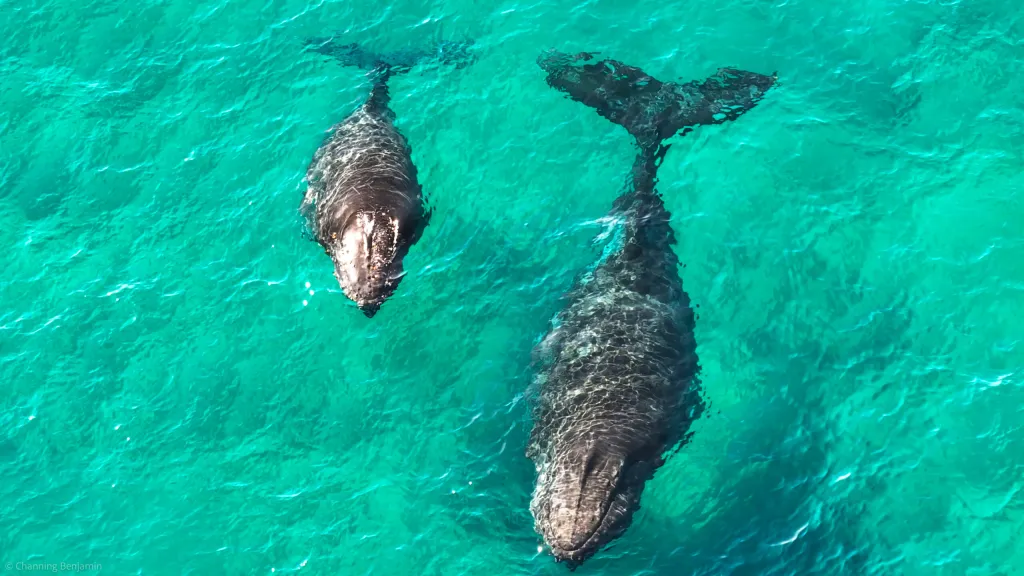
Humpback whales (Photo: Courtesy Channing Benjamin)
For scuba divers, Los Cabos is known as the “aquarium of the world”, a name bestowed here by legendary marine biologist Jacques Cousteau 50 years ago. It is the Cabo Pulmo National Marine Park that draws the most attention among avid underwater explorers as more than 800 species of marine animals live within the confines of this 70 sq. km. reef and oceanic ecosystem that was designated a UNESCO World Heritage Site in 2005.
Sport fishing is also one of the most popular outdoor activities in Los Cabo. It is here the Bisbee’s Black and Blue marlin fishing tournament is held every October where the world’s best anglers compete for bragging rights and a share of a $3 million purse.
And then there are the Los Cabos sunsets. If you appreciate the radiant hues our biggest star generates, there isn’t a better place on the planet to watch the colours of the sky illuminate than the on beaches of Los Cabos.
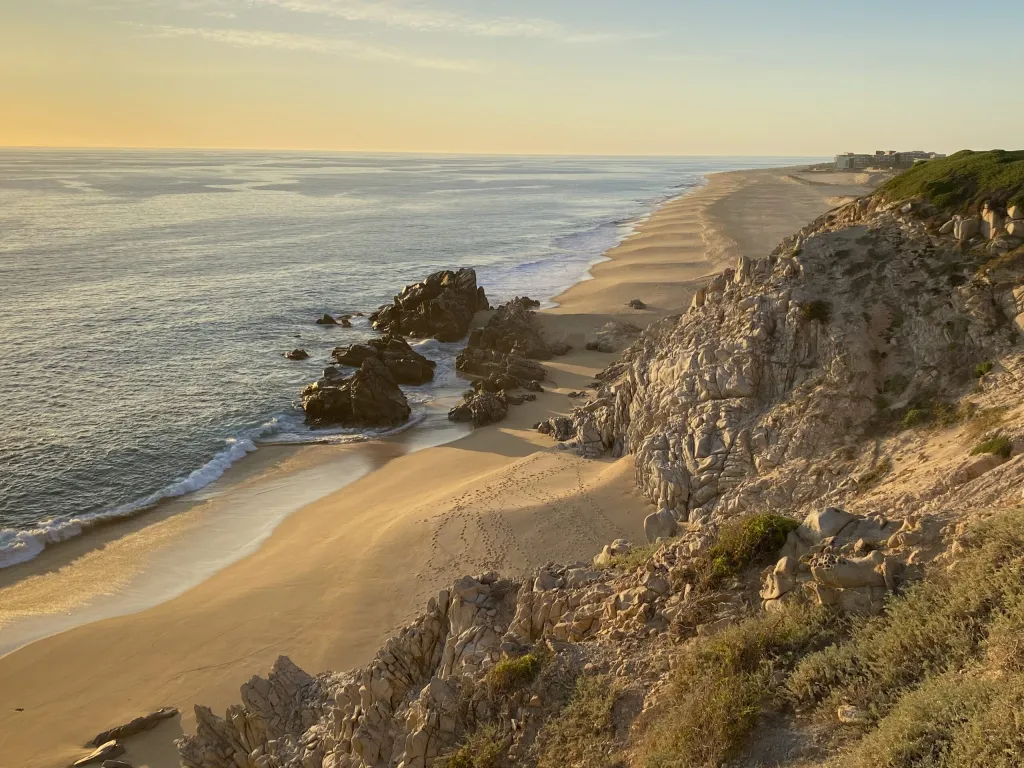
Sunset on the Beach
And finally, there are the golf courses of Los Cabos. Much has changed over the past 30 years when the only venue in town was a short 9-hole, government owned golf course. Just as he transformed the game itself when he played, Jack Nicklaus put Los Cabos on the golf world’s radar having designed six of the 18 courses that now comprise the area’s golf repertoire. As to be expected, others followed Nicklaus’ lead including the likes of Fazio, Love, Norman, Player, Weiskopf and Woods, all of whom have contributed to shaping the Los Cabos golf landscape.
One of the best of the bunch is Quivira (pronounced key-vee-ra), the brainchild of Mexican businessman and resort developer Mr. Ernesto Coppel, and centerpiece of an 1,850-acre master planned luxury residential and resort community located 10 minutes from downtown Cabo San Lucas.
Having recently celebrated its 10th anniversary, Quivira is Nicklaus’ sixth Los Cabos design and arguably his best. Already ranked the 87th best golf course in the world according to Golf Digest, Quivira took more than 10 years to construct epitomizing the saying, “good things come to those who wait”. It was during the opening ceremony when Nicklaus described Quivira as, “one of the great pieces of property in the world,” and saying, “we tried to create some excitement on the mountain and in the dunes, and I believe we’ve created a golf course that plays as spectacular as it looks.”
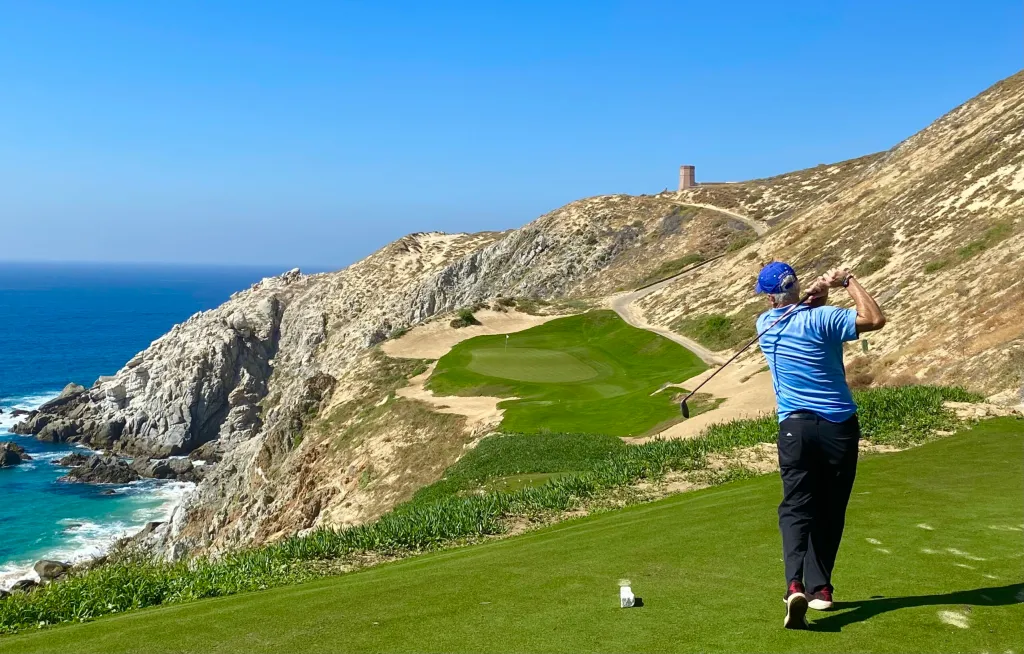
Not your ordinary tee shot!
Mission accomplished Mr. Nicklaus as Quivira gets a 10/10 on the “Wow Factor.” Measuring 7,019 yards, the golf course sits precariously atop the granite cliffs of the Pacific Coast contiguous to desert and sea. It is one of the few golf courses in the world that could be accurately described as an ocean, desert, links, or mountain course, or all the above. How you describe Quivira is your call and will likely lead to a spirited discussion with the others in your foursome after your round. Regardless of the outcome, it’s hard to ignore the fact that from every fairway, you will be afforded breathtaking views of the Pacific Ocean, a claim few other golf courses in Los Cabos can make.
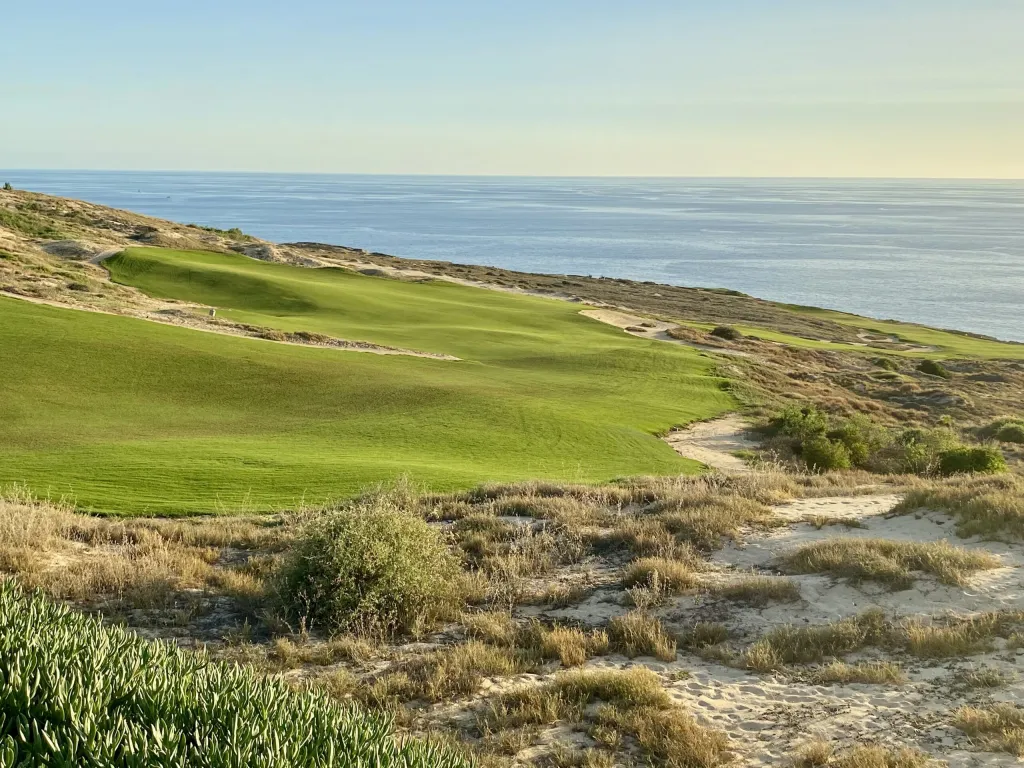
QUIVIRA Hole #13: Ocean, Desert, Links, or Mountain. You decide!
Another undisputed claim Quivira can make is that Faro Viejo, the historic lighthouse that sits adjacent to the par 4, 409-yard, 8th-hole, is Land’s End of the Baja California peninsula. Built in 1905, this iconic landmark serves as kilometer zero on the North American continent and the southern-most demarcation point where the Pacific Ocean and Sea of Cortez unite. If time permits, take a walk around the perimeter of the building. Plaques adorn the side of the structure explaining the significance of the lighthouse to the area. Don’t be surprised if you see a pod of migrating Humpback whales frolicking in the distance as you return to the tee.
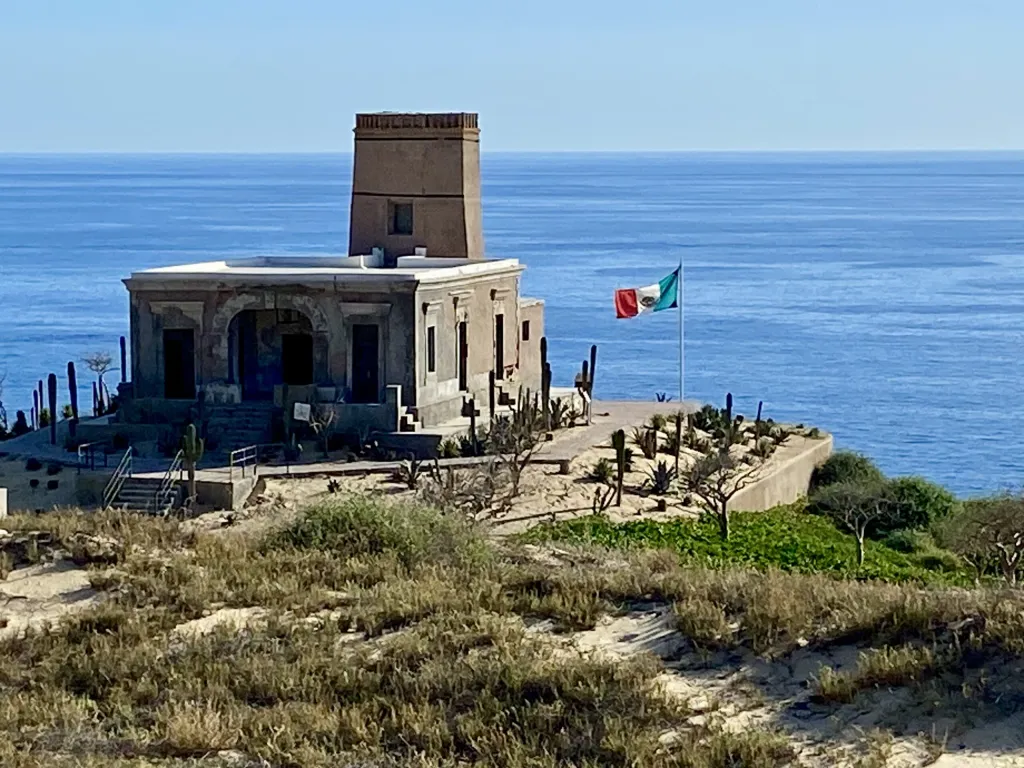
Faro Viejo, Quivira’s Historic Lighthouse
As you turn inward, the essence of the golf course changes as the windswept dunes and rolling desert foothills lead you towards the “Oasis”, the halfway house situated adjacent to the ninth green. It is here where several of the resort’s chefs eagerly await your arrival to showcase their delectable Baja cuisine.
Throughout the back nine, Nicklaus took great care to protect the indigenous shrubs, trees and cacti to ensure Quivira’s desert golf persona remained intact. Of all the desert flora, be sure to take notice of the towering, multi-armed, cardon cacti, many of which are hundreds of years old.
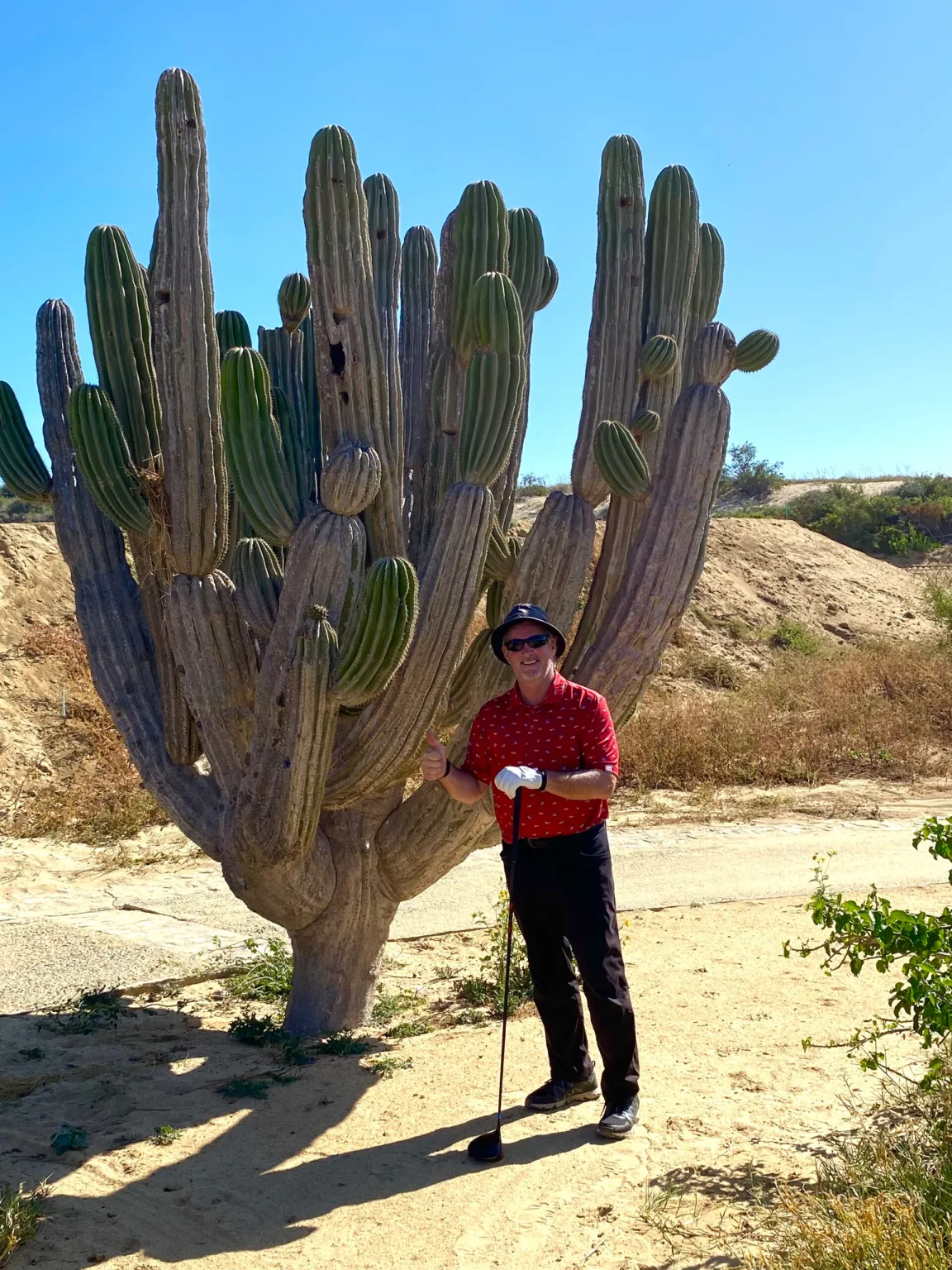
A magnificent 100-year-old Cardon Cacti and the author
While Quivira may be able to boast having 18 signature holes, one in particular was most memorable. It was along a winding one-mile ascent from sea level to the dramatic par 4, 310-yard, 6th hole that the grandeur of Quivira first became apparent. Weaving our way from the base of the 5th green, it took several minutes to arrive at the 6th tee, a postage stamp-sized hitting area carved tightly into the side of a sheer granite cliff 300 feet above crashing waves below. When asked to describe the 6th hole, Nicklaus stated, “from the first time I saw this extraordinary site, I knew this would be an amazing location for a short par 4. It is the character of the hole that makes it one of the most visually stunning par 4’s in the world.”
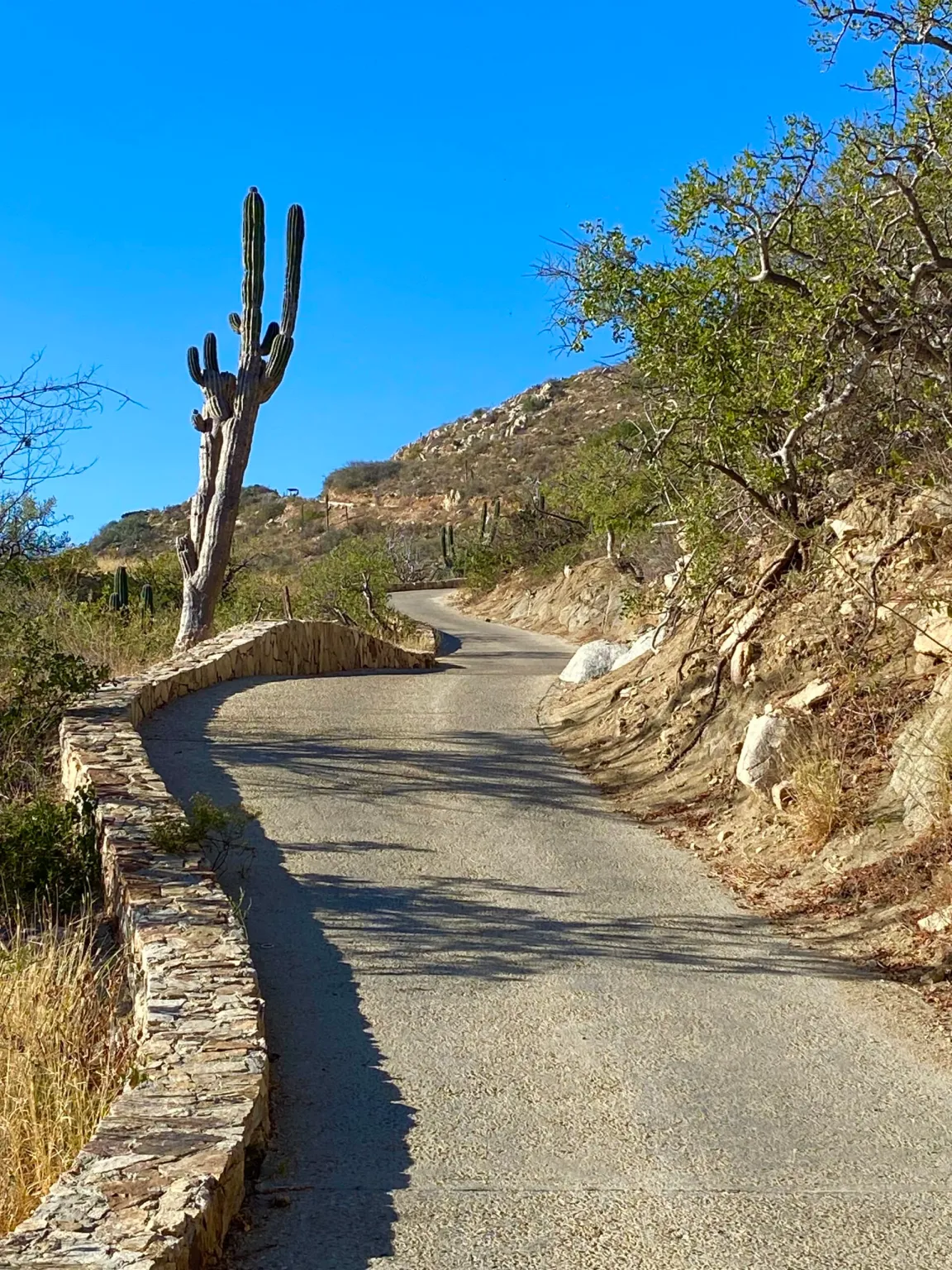
The winding one mile drive to the 6th tee
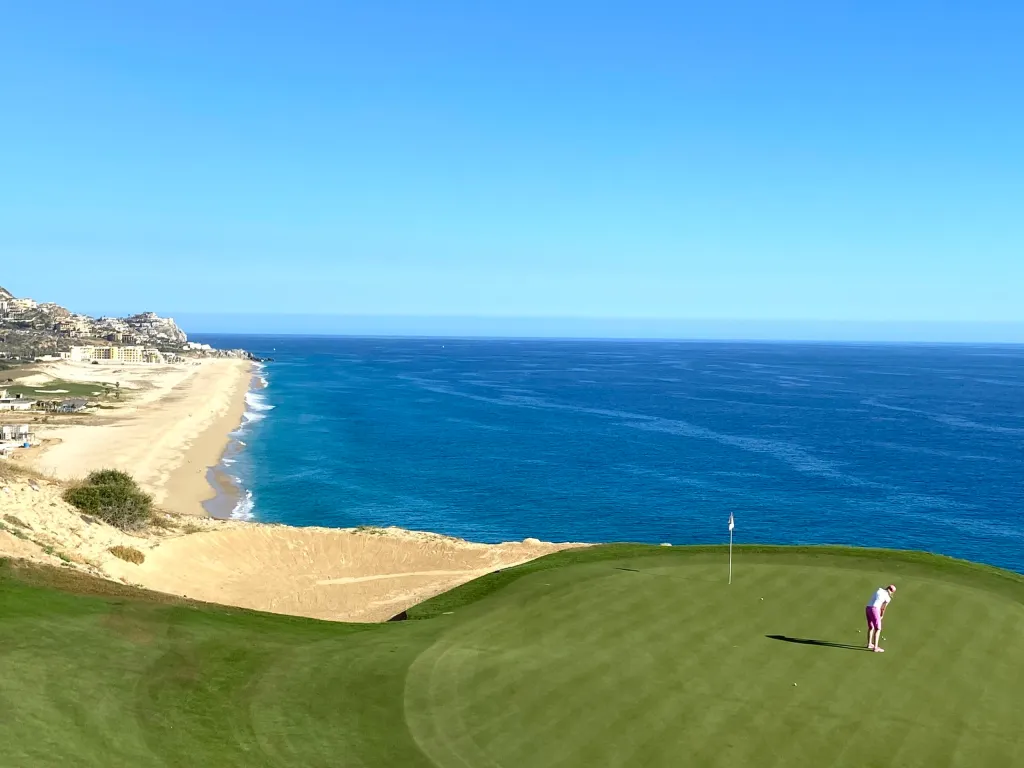
Greenside at the 6th hole, Nicklaus’ favourite par four
Before heading to the 6th tee, be sure to stop at the “Cliffs”, the first of four on-course “grab-and-go” comfort stations where you are encouraged to stop for a drink and savour the panoramic view. Take a few minutes and swap your driver for your I-Phone for the first of Quivira’s many jaw-dropping photo-op sessions.
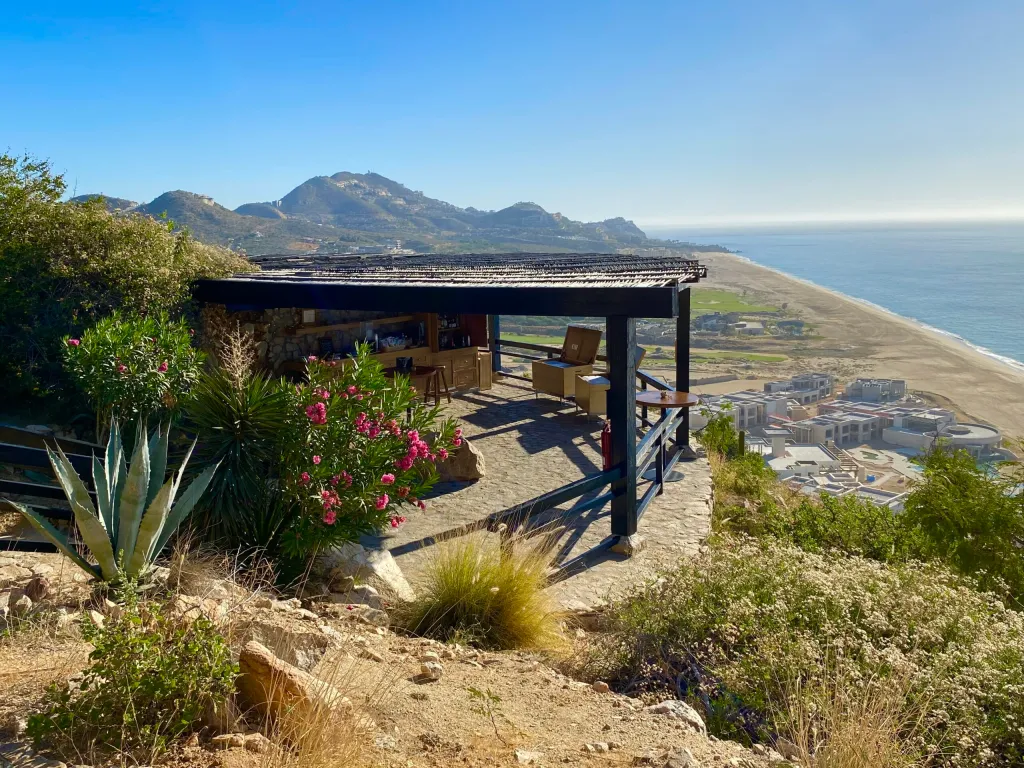
The view from the cliffs
While I wouldn’t describe Quivira as a public golf course, access to the golf club is available only to real estate owners in Quivira Los Cabos (Alvar, Copala, Coronado, Mavila, Novaspania, and Old Lighthouse Club communities) and guests of any of the four Pueblo Bonito Resorts (Pacifica, Sunset Beach, Rose, and Los Cabos Beach).
Of all the resorts, the Pueblo Bonito Pacifica Golf & Spa Resort is closest to the golf course. Nestled on a secluded three mile stretch of pristine beach in Cabo San Lucas, the Pacifica Resort is an all-inclusive luxury resort exclusively for adults. The 154-room retreat features four restaurants, four bars, the Armonia wellness-inspired spa, and access to a private beach. The Towers at Pacifica, three ultra-luxury buildings at the resort, take 5-star service to another level by providing guests with additional amenities including their own private butler service. Golf at Quivira is a-la-carte but easily arranged in advance of your arrival or via the resort’s concierge. Like the other top courses in the area, Quivira is not inexpensive as green fees range from $275 -$380 USD October through May.
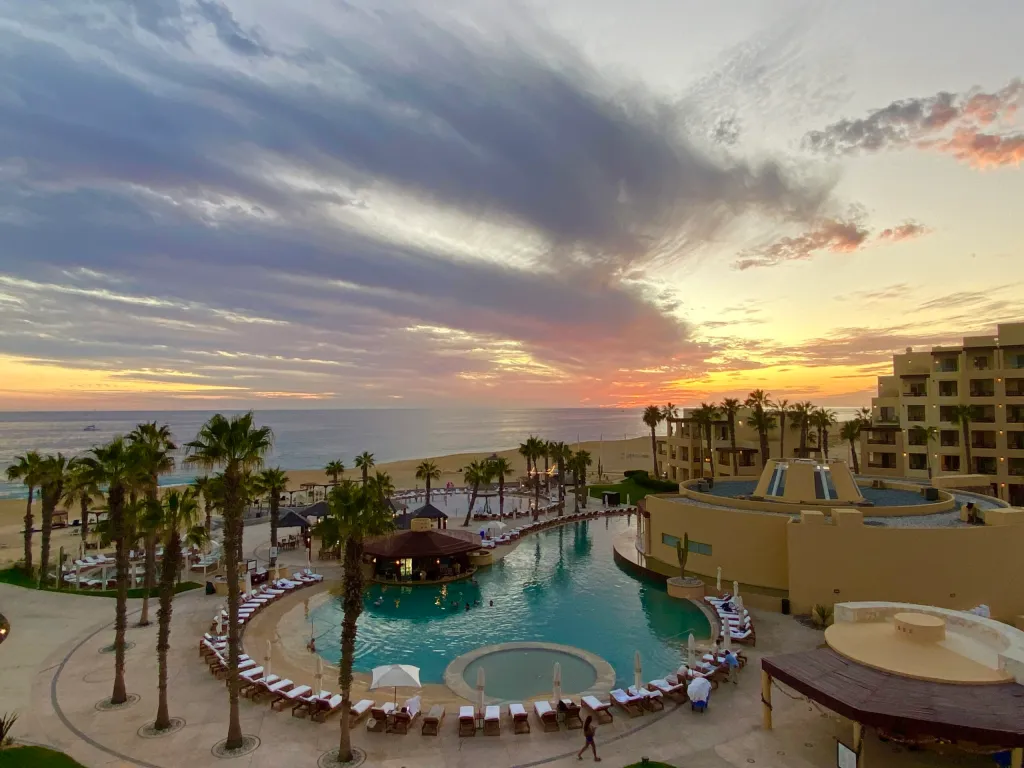
Pueblo Bonito Pacifica Golf & Spa Resort
My only regret about my recent visit to Los Cabos was that it was too short. I could have stayed at the Pueblo Bonito Pacifica Golf & Spa Resort for weeks and played Quivira multiple times – especially during our winter months – and further expanded my sampling of all Los Cabos has to offer. Whether you come to play some of the world’s best golf courses, participate in a scuba diving or whale watching expedition, experience Mexican culture, or simply relax and rejuvenate, Los Cabos will not disappoint. This is a special place worthy of all the accolades it receives. Come and discover it yourself.
How to Get There:
Both Air Canada and Westjet fly to Los Cabos throughout the year.
Where to Stay:
There are four Pueblo Bonito resorts in Los Cabos to choose from. All are exceptional and uniquely different including the Pueblo Bonito Pacifica Golf & Spa Resort where I had the pleasure of staying. For more information about all of Pueblo Bonito accommodations visit www.pueblobonito.com
Golf in Los Cabos:
Quivira Golf Club: www.quiviraloscabos.com/golf
Information about Los Cabos:
A complete Guide to Cabo San Lucas: www.allaboutcabo.com
Visit Mexico: www.visitmexico.com
